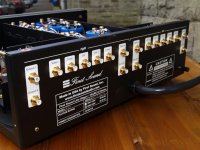Is this your preamp?
Do you see the far left and right RCAs say "Qutput 1 and Output2".
Many preamps have this feature, those outputs are essentially identical.
There are
phono preamps that have that feature as well. They have
2 sets of outputs.
You can take
one of those and run it straight into Line 1. You could take the other and run into Line 2. Switching between Line 1 and Line 2 on your preamp should result in identical sound, barring a level difference between the 2 (humans can detect very small changes of intensity...but it is not perceived as "louder" (which it actually is), but "different", or "better".
Now we take one of the 2, say the one going into Line2 disconnect and instead connect it to an Analog to Digital Converter, aka ADC. We can sample that signal at whatever rate, 44, 48, 96k, etc. We then feed that "digitalized" signal into a DAC.
That output is fed to Line 2...and very carefully voltage matched to the Line 1 signal, again, so there isn't a "louder" signal.
Both signals carry every pop, tick, crosstalk, etc, etc, etc. because both are being sent from the same phono pre, same TT, same cartridge, etc.
We have used critical thinking and isolated just the "digital" conversion process on an identical signal, in real time. Again, everything off the record is coming through clearly on both Line 1 and Line 2. Mr Wayne switches between 1 & 2 and very easily identifies the "sonic signature" of the "digital" he has asserted innumerable times.
There is a slight catch, because knowing which is Line 1 and Line 2 will instantly identify the signal.
So I have a rather special preamp specifically designed for this, using hi end switches, no caps in signal path, blah, blah that can "hide" the differences that manifest when the imagination runs rampant.
This preamp has an A and B input...and then will randomly generate an output from either one, called X. Now the listener no longer knows which is which, so they have to "trust their ears" and "just listen", something you see claimed about a 1000x second on many forums.
No blindfolds are used, that's a bit of a joke. The listener simply uses their highly self trained, self graded 2 ears. It's highly revealing of differences if you've tried it
https://www.dagogo.com/audio-by-van-alstine-abx-comparator-review-part-1-audio-store-wiring/
On a side note, one of the participants at my last session said he attended a similar one done by John Atkinson, many moons ago in England.
lots of fun and belly laughter, but unfortunately, same results. Nothing new its seems.


